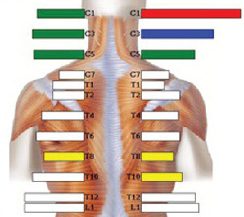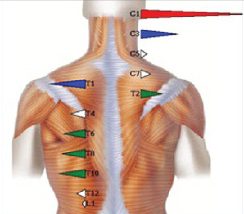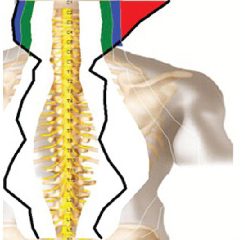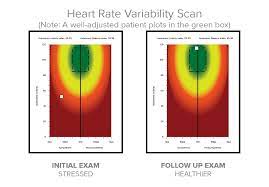Breaking New Ground in Reliable & Actionable Analytics for Chiropractors

The principles behind the neuroTHERMAL™ Scanner Thermal readings have been used among chiropractors and other wellness specialists for more than a century to monitor health and wellness. Thermal technology was first used for chiropractic care in 1924 by Dr. B.J. Palmer. Since then, chiropractic thermal scans have been repeatedly cited as an accurate way for chiropractors to gain actionable insight into each patient’s well-being and how it is influenced by chiropractic care. Thermography is just one of the channels through which CLA’s INSIGHT™ system breaks new ground in reliable and actionable analytics for chiropractors.
The neuroTHERMAL Scanner is a thermal body scan technique measures paraspinal temperature differential. A significant difference in the temperature on each side of the spine could indicate a lack of autonomic responsiveness, an important indicator that something could be wrong with one or more organs.
The INSiGHT neuroTHERMAL™ Scanner is a rolling segmental thermal scanner that uses infrared sensors to take temperature readings. This innovative piece of chiropractic equipment was designed to evaluate autonomic nerve function. It uses normative comparison and reporting based on data from the Journal of Neurosurgery. For chiropractors and patients, the neuroTHERMAL™ Scanner presents an opportunity to establish a baseline for temperature differentials that can be referred to throughout the course of care. From here, chiropractors can help patients identify signs of progress and gauge where there is room for improvement on the path to greater wellness. In addition, the neuroTHERMAL™ Scanner has an adjustable sensor array. This patented breakthrough lets chiropractors take readings from any sized spine whether it be newborn, infant, child, or adult.



Surface EMG (SEMG)
What is sEMG and how can it support chiropractic care?
This technology reads electrical activity (action potential) in order to measure paraspinal tension, similar to the use of electromyography in EKG/heart rate measurement machines.
The electric current pattern is a critical component in how your body functions. The muscles on either side of your spine should be balanced: if they are not working equally well, the body is forced to compensate, which takes energy. This imbalance can be monitored by sEMG technology. Alterations in electrical activity in the paraspinal muscles can shed light on the muscular changes linked to vertebral subluxations. As such, chiropractors can use sEMG to establish a baseline for paraspinal electrical activity.
In contrast to EKG/heart rate monitors, the sEMG used within CLA’s INSiGHT™ technology has sensors that are 1,000 times more sensitive. This enables them to read the electrical activity of paraspinal muscles, which is much weaker than that of the heart. The sensitivity and accuracy of the Insight technology are unsurpassed.
Amplitude scan – This scan reveals the amplitude (tension) among paraspinal electrical activity, noting areas of hyper or hypo-tonicity as it compares to a normal population. CLA’s chiropractic tools use a color-coded system: Green bars show mild elevation (compared to the normal scan), blue bars convey moderate elevation, red bars indicate high elevation, and yellow bars display readings below normal amplitude.
Asymmetry scan – This reading depicts the amount of muscle pull from one side to another along the spine using the same color-coded system. White triangles indicate normal.
SEMG-Pattern view – This cutting-edge graph is patent-pending and unique to CLA’s INSiGHT™ technology. It highlights patterns in how energy is distributed throughout the spine and whether this system is efficient or not. With this view, chiropractors can easily visualize underlying imbalances and room for improvement for patients who are interested in better wellness.
Heart Rate Variability (HRV)
What is HRV and how does it affect well-being?
HRV refers to the beat-to-beat variability of the heart and provides incredible insight into autonomic nervous system function. Though it may seem counterintuitive, a higher HRV is actually a good thing: it means that there is greater variability in the time between heartbeats so this organ is better able to respond to stress, sickness, or physical activity. The more adaptable a patient’s heart, the less damage any stress-related spikes will be for overall health and well-being. With the neuroPULSE™, chiropractors can establish a baseline HRV for each patient. This provides a concrete starting point to track a patient’s progress as they work toward wellness.

What Data is Collected From a PWP Scan?
During a scan, the neuroPULSE™ collects data on the Instantaneous Heart Rate (IHR) throughout the unattended, 5 minute scanning period. This information is used to determine the variability in heart rate and is presented in an easy-to-interpret graph. Any unexpected variances in nervous system stimulation are measured as Skin Conductance Response values.
Once this data is collected, the INSiGHT software calculates the HRV measurements to assess the state of the autonomous nervous system (ANS). This screen compares the two branches of the ANS: parasympathetic versus sympathetic responses. The neuroPULSE™ can reveal if these branches are balanced (as they should be), or if one component is stronger.
